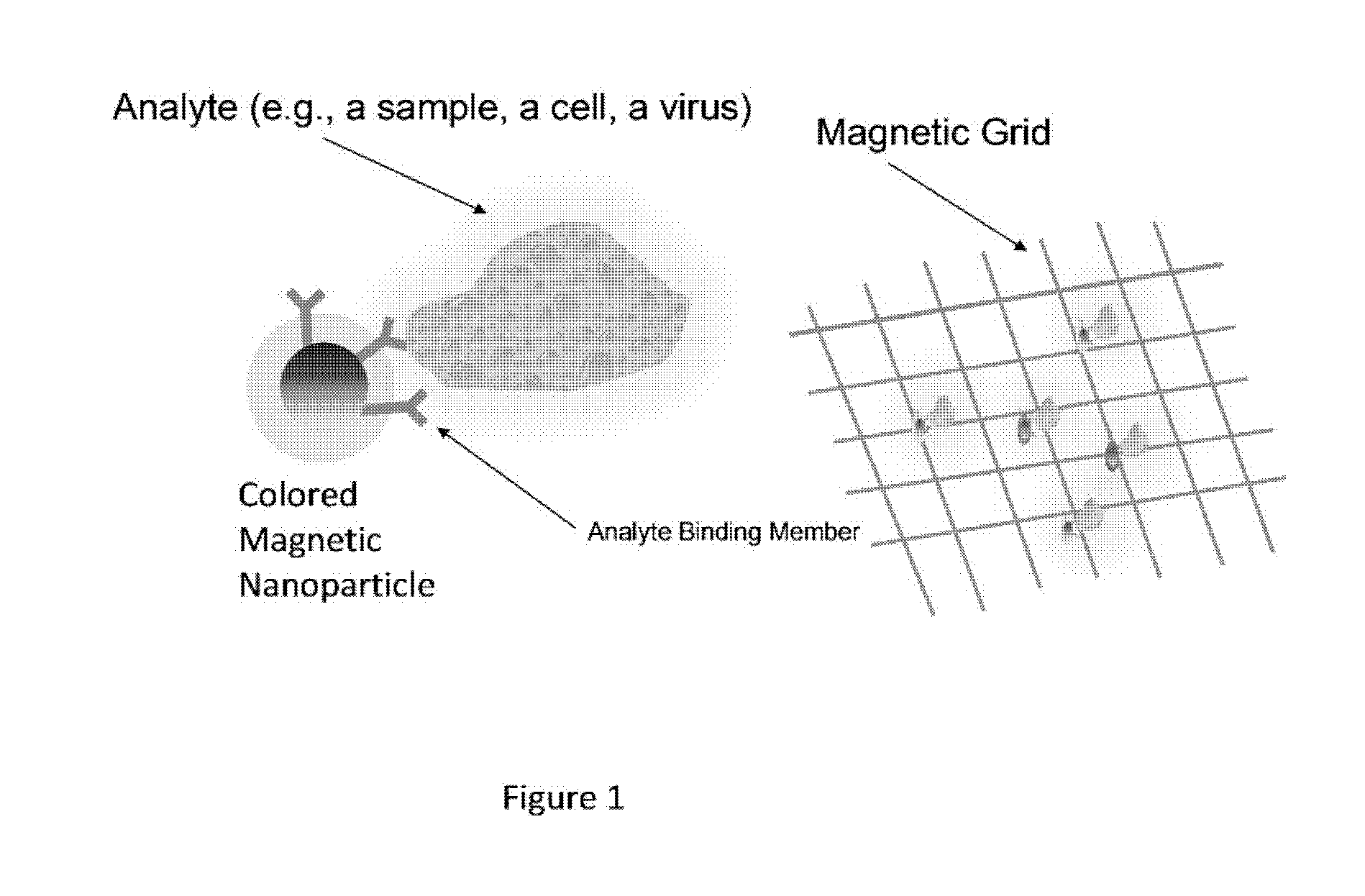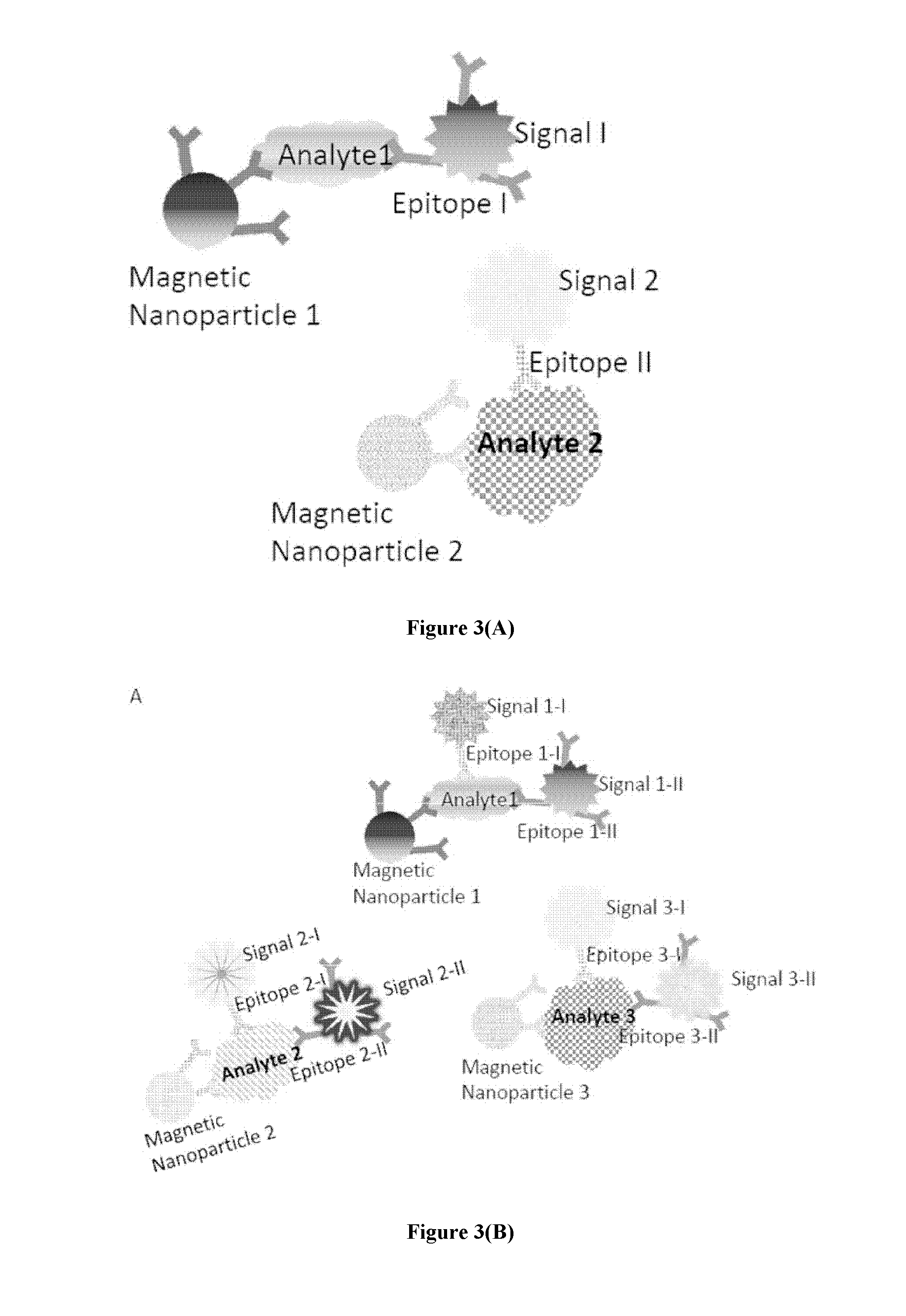Multifunctional nanoparticles for molecular and cellular separation, detection and quantification
a multi-functional, nanoparticle technology, applied in the field of biological samples can solve the problems of limited current molecular and cellular detection, and achieve the effect of easy response to external magnetic field control
- Summary
- Abstract
- Description
- Claims
- Application Information
AI Technical Summary
Benefits of technology
Problems solved by technology
Method used
Image
Examples
example 1
Preparation of Nanoparticles of Gold and Semiconductor Quantum Dots with the Low Density Siliceous Structure
[0152]The low density siliceous structure is a versatile and flexible platform for making biocompatible nanoparticles. For example, to incorporate gold nanoparticles into the siliceous structure, Au nanoparticles synthesized in either water solution or organic solutions could be utilized. Briefly, Au was precipitated out at the sample vial bottom after centrifuge at 13 k rpm for 15 min, then silane molecules such as aminopropyltrimethoxysilane and TMAOH was added. The reaction solvent was adjusted using a higher number alcohol, such as butanol or proponol. Then the sample was sonicated for a few hours with constant blowing of air bubbles, afterwards, PEG-silane, mercaptopropyltrimethoxysilane and aminopropyltrimethoxysilane were added, the sample was sonicated for additional 2-3 hours. Afterwards, mixture of chlorotrimethylsilane, methanol, and TMAOH or other silane molecules ...
example 2
Preparation of Nanoparticles of Semiconductor Quantum Dots with the Low Density Siliceous Structure
[0153]As another example, semiconductor quantum dots in the form of individual nanocrystal or nanocrystal clusters could also be incorporated within the highly porous / low density siliceous structure. For example, CdSe / ZnS nanoparticles in organic solvents such as chloroform, Toluene, or Hexane could be precipitated out by adding methanol and then through centrifugation. The nanocrystal pellet was then re-dispersed in aminopropyltrimethoxysilane or mercaptopropyltrimethoxysilane. Afterwards, tetramethyl ammonium hydroxide was added. Then the reaction solvent was adjusted using a higher number alcohol, such as butanol or proponol. After sonicating the sample for 1-4 hours and blowing air bubbles, small amount of aminopropyltrimethoxysilane, mercaptopropyltrimethoxysilane, polyethyleneoxidesilane and water was subsequently added, and the sample then underwent sonication for another 1 to 4...
example 3
Preparation and Characterization of Low Density Magnetic Particles
[0154]Preparation of the Magnetic Porous Nanostructure:
[0155]Magnetic particles formed by clustering multiple small particles and then being coated were prepared. The clustering happened with the addition of a worse solvent for generating dispersed nanoparticles, such as butanol or isopropanol, followed by the addition of the silanization reagents to form the nanostructure under constant blowing of air bubbles. The magnetic nanostructure as prepared was observed under TEM (FIG. 12). As shown in FIG. 12, each large core nanoparticle comprised a cluster of small nanoparticles, and the coating was substantially invisible under TEM.
[0156]Characterization of Density of the Coating:
[0157]To calculate the density of the coating, both the dry mass and the volume of the coating were characterized.
[0158]Since the magnetic particles had high magnetic response that they could be directly captured using a magnet. This allowed gene...
PUM
| Property | Measurement | Unit |
|---|---|---|
| pore size | aaaaa | aaaaa |
| porosity | aaaaa | aaaaa |
| porosity | aaaaa | aaaaa |
Abstract
Description
Claims
Application Information
 Login to View More
Login to View More - R&D
- Intellectual Property
- Life Sciences
- Materials
- Tech Scout
- Unparalleled Data Quality
- Higher Quality Content
- 60% Fewer Hallucinations
Browse by: Latest US Patents, China's latest patents, Technical Efficacy Thesaurus, Application Domain, Technology Topic, Popular Technical Reports.
© 2025 PatSnap. All rights reserved.Legal|Privacy policy|Modern Slavery Act Transparency Statement|Sitemap|About US| Contact US: help@patsnap.com



